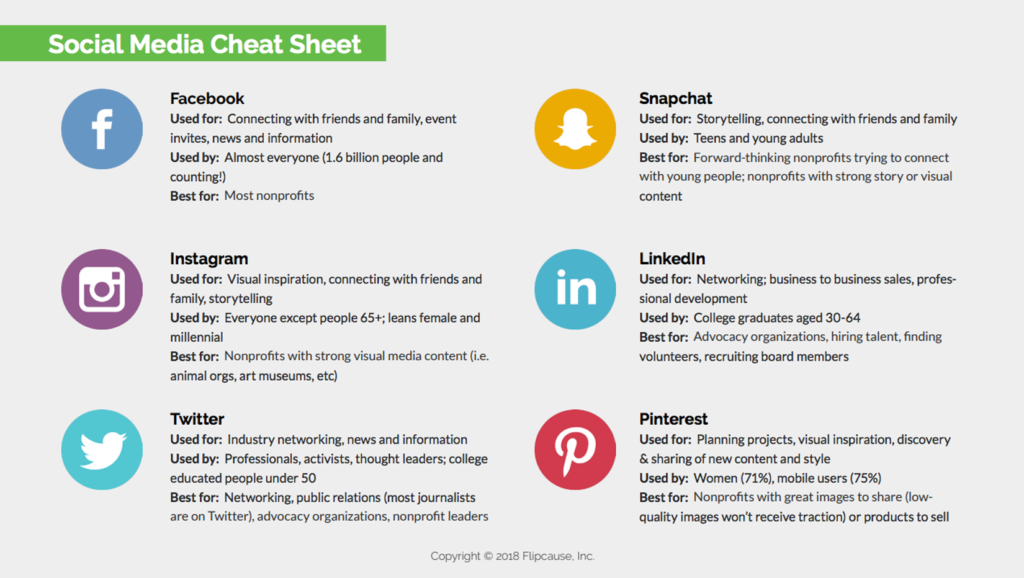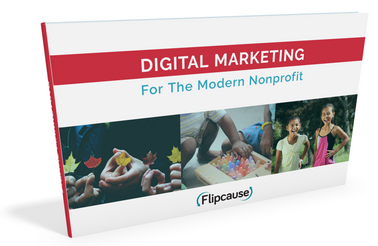Social Media Engagement for Nonprofits: 5 Key Steps
Most nonprofits have a Facebook page, if not one or two other social media accounts, that they use primarily as a communication channel. They reuse content from other sources, create Facebook events, and respond to supporter questions. This level of engagement is great, but it’s not an effective way to get followers to become supporters.
The truth is: it doesn’t matter if you have thousands of Facebook followers if none of them will ever donate, volunteer, or spread the word.
With over 3 billion active social media users worldwide (according to the latest research), social media is a powerful tool to engage your community and build support for your cause. Use the steps below to get strategic with your social media messaging—and get others to help you change the world!
1. DEFINE YOUR AUDIENCE
Social media is just that – social. Just like in real life, not everyone is going to be friends. You want to connect with other people who share your vision and values.
So how do you know who these people are and how to reach them?
You can start with the people who already care about your mission: staff, volunteers, and donors. Your current social media followers will also reflect information about your potential audience. Make a list of characteristics your supporters share, including:
- Age: You can group your supporters into 18-24, 25-29, 30-49, and 50+
- Gender: Male? Female? or Other?
- Occupation(s): Are they professionals in a particular field? Homemakers? Students?
- Location: Where do they live and work?
- Interests and Values: What do they care about? (Volunteering? Animal rights? Healthcare?)
Your Donor Personas will also give you lots of information to work with. Defining your audience prepares you to pick the right platform to reach them. It will also provide valuable insights when you are ready to dive into paid social media and targeted advertisements (more on that next week).
2. PICK YOUR PLATFORM
It’s hard to be an expert on any one social media platform, yet legitimate businesses and nonprofits are expected to maintain several different accounts. While we don’t recommend doing them all, it’s worth the effort to know the differences of each and pick just a couple to become well-versed in. The right platform(s) can become a vital part of your nonprofit’s marketing strategy, and your accounts can serve as important venues for cultivating relationships with your supporters.
However, just because your nonprofit has an active Facebook doesn’t mean you can automatically utilize Twitter or LinkedIn effectively. Each platform has its unique set of uses and capabilities, reaching different kinds of networks.
Once you’ve defined your audience, check out our overview of the most popular social media platforms. Depending on who you want to reach, there may be a lot more potential for capturing a specific audience on one of them.
Our Know Your Social Media Platforms post takes a more in-depth look at the most commonly used social media platforms. It can help you understand the differences between them and which one will work best for your organization. Whatever platform you choose, dedicate yourself fully to it. This means that you should do more than just post content. Connect with others, join groups, tag partners, and respond to comments.
3. CREATE A UNIQUE ONLINE VOICE
Once you’ve picked the best platform to reach your existing and potential supporters, it’s time to start crafting your content. Take a moment to think about your favorite pages on Facebook or Instagram. What do you like about them?
Examples we love:
One incredibly popular Facebook page is Humans of New York, which features the portraits and intimate thoughts of the many diverse people living in the city, captured in an interview format.
Another great feed is the National Forest Foundation Twitter, which features gorgeous wildlife photos and facts they know their followers will connect to. Both of these pages found a specific type of post that worked well for them and stuck to it.
Social media provides a unique opportunity to share your organization’s perspective. Some organizations have a charismatic leader who can be the “voice” of a nonprofit on Twitter or LinkedIn. Some use content generated by their audience or focus on featuring the clients they’re helping.
Whatever you decide to do, create something your audience will come back to again and again.
4. GROW YOUR ENGAGEMENT ORGANICALLY
We talked earlier about how social media is social. So it makes sense that the algorithms social media platforms use to share your content favor posts that receive attention. We call this “engagement.” What this means is that the more people Like, Comment, or Share your posts, the more people will see them. This kind of engagement is called “organic,” which is using social media without paying for it.
While you can use paid social media advertising, nonprofits should take advantage of these simple ways to increase engagement for free:
- Post regular updates
- Always tag/mention people and partners in your posts
- Use hashtags (#) to increase the visibility of your content
- Follow and engage with influencers in your field. A re-post, re-tweet, or Like from someone with a large following can boost engagement with your page and content
- Add social media buttons to your website and blog
- Use your email list to grow your following: send a dedicated call-to-action email asking supporters to follow your organization on social media
You can also use offline tactics to grow your social media engagement organically:
- Make sure your real-life supporters are also your friends on social media. Ask them to follow you when you see them in person!
- Talk with your staff about following your social media profiles, and
- Encourage them in-person at meetings to share your content with their networks
5. MEASURE RESULTS AND REFINE YOUR STRATEGY
Building engagement through social media is hard work. A “set it and forget it” mentality can get in the way of your social media success, so don’t skip this last step! Use your social media metrics to learn what works best (and what might not work) for your organization.
Common KPIs (Key Performance Indicators) include:
- Post Likes
- Post Shares
- New followers
- Link clicks
So how do you measure them?
Each social media platform has an analytics dashboard that provides basic data on your page and followers. These built-in reporting tools will help you keep track of engagement over time.
When you look at your data, consider the following:
If a particular post received a lot of Likes or Shares, was it about a specific volunteer? A featured blog post? A video? Your most successful posts can become templates for future content.
On the other side of that coin, posts that don’t get much (or any) attention can help you better understand your followers. They are an opportunity to learn what and when not to post.
As you build and refine your social media strategy, remember: it’s a process. What works for each organization will look different and may change over time. These steps provide a path to increased social media engagement and broader support for your cause.
Have a question about engaging your supporters on social media? Or a story about what works for your organization? Share with our community in the comments below!
Download our free eBook to learn more about Digital Marketing for Nonprofits
[email-download download_id=”3834” contact_form_id=”1369”]



Good article but doesn’t provide any real tools or metrics for a non-profit to measure the effectiveness of a social media campaign to promote a specific event. For example, if a non-profit posts on Instagram, FB and Twitter to promote an upcoming event how can the non-profit know how many attendees actually saw those social media posts and came to the event specifically because of those social media posts? Counting post likes, post shares and link clicks isn’t actionable information when it comes to the above example.
I’m not arguing that social media postings for a non-profit are a waste of time , there are just very few useful tools to accurately measure its effectiveness.
Any comments or suggestions?
Hi Ted,
Great question!
First, I recommend reading the section on social media from the Digital Marketing for Nonprofits eBook that this post is from (it’s linked at the bottom of the post). This covers metrics and conversions more in depth and also goes deeper into social media marketing – when you pay these channels, they will definitely give you more insights regarding conversions and effectiveness of campaigns.
Second, you should also be using a tool like Google Analytics (this is free). You plug in the code into your page (say, your event registration page) and it will tell you how many visitors came from where – be it organic search, advertisements, or social media posts. It will even tell you exactly which posts. Looks like we don’t have an article about this yet on our blog (on my to-do list!) but an internet search will pull up a lot of getting started guides.
Third, if you are interested in advanced level Facebook marketing, we recommend checking out facebook.com/FundMyNPO – they have a track record of 5-20X return-on-investment on their Facebook ads!
I hope this is helpful!
The blog is really awesome and very informative. I actually agree with the different tips that you have suggested for the nonprofit social media followers, but there are still different ways of growing or improving your website. Anyways, thank you for sharing your blog.
Hi Aditya. Thanks, and we’re so glad to hear that our blog has been informative for you! You’re right— this is just the start to growing your engagement, and there are so many other ways to do it. If you haven’t already, be sure to check out our Digital Marketing for Nonprofits eBook (linked below) for a deeper dive into social media marketing. Let us know if there are any specific topics you’d like us to write about in the future. And of course, feel free to share your own tips here if you’d like!
This was helpful to read. I do have a question though. When you have an audience that really could be just about anyone at any given point in time, how do you know where to reach them, and how to engage with them? For example GoFundMe, or MealTrain… Those could potentially be used by anyone depending on their current circumstances. I can post ideas and inspiration and stories all day long, but how do you grow your audience and engage them when the audience is so undefined.
Hi Stephanie, I’m so glad this was helpful for you. Great question! While it may seem counterintuitive, narrowing down your appeal to a more specific audience can maximize your ROI. You may appeal to less people, but you will convert more of the ones you are specifically calling on.
Start by figuring out who your primary audience is and defining the persona for the majority of the people you want to appeal to. If you have any past donor data to consult, use it to uncover any trends. You can further define your audience by checking out the analytics per social media channel to figure out different audience types per channel, and further tailor the language of your asks. If you haven’t already checked it out, we have a blogpost on Donor Personas here. And here’s more on Where To Find New Donors, starting with your immediate network.
Another strategy for engagement is to focus on the elements of storytelling and crafting the language to match the personas. Don’t be afraid to make it personal, use “you” language, and connect the donor with being part of the solution to make it more compelling. I hope this helps!